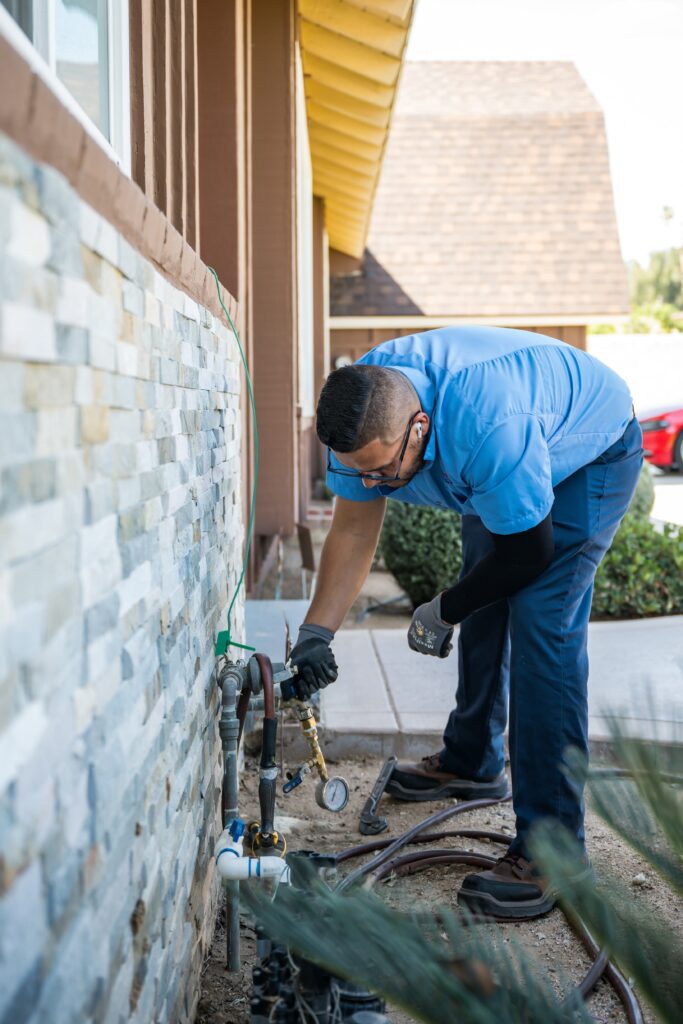Whether you have an old home or a new one, there are always ways to save water. Here are some quick and easy recommendations to improve the water-use efficiency in your home.
Checking and Repairing Water Leaks
One of the biggest wastes of water in and around your home is leaks from leaky pipes, toilets, and faucets. On average, leaks can account for 3 to 6 percent of your total water usage! Luckily, checking water leaks can be quite easy.
- 1
Step One: Turn off all water-using fixtures and appliances. If you have an automatic ice maker, make sure it is off also. Once you know all the water is off, go to your water meter (located in the front yard).
- 2
Step Two: Check to see if the dial on the meter is moving. If the meter dial is moving, you have a leak. If you are having trouble reading your meter, JCSD’s Customer Service Department can check your meter for you.

If you have a leak, investigate all water-using appliances and fixtures to determine the source of the leak. While wet and audible leaks are most common, sometimes leaks can be hidden and silent. In such cases, you may want to consult with a professional plumber or irrigation specialist.
Bathrooms
Toilets
- Update toilets to new premium high-efficiency toilet (HET) models that use 1.06 gallons per flush (gpf) or less. Look for the Water Sense label to ensure the model you select has gone through quality testing.
- Toilet leaks can waste up to 60 gallons of water per day. The most common toilet leak is from a bad toilet flapper. Toilet flappers are inexpensive and can be quickly and easily installed.
Showers
- Replace current showerheads with newer models that use 2.0 gallons per minute (gpm) or less.
- Keep your showers short! Remember, a 5-minute shower uses half the water that a 10-minute shower uses.
Faucets
- Replace your current bathroom aerators with 0.50 gpm models. JCSD provides customers with one free bathroom aerator that is available to pick up at the JCSD office. Video link.
Kitchen
Faucet Sink
- Replace your current kitchen aerators with 1.0 gallons per minute (gpm) models. JCSD provides customers with one free kitchen aerator that is available to pick up at the JCSD office.
- Remember, do not leave the water running while washing dishes.
- If it takes a long time for your water to get hot, consider using the cold water for watering houseplants. No patience? An instant hot-water-ondemand system connected under the sink can produce immediate hot water!
- Regularly check around and under the sink for leaks which can waste up to 15 gallons of water a day!
Dishwashers
- Only wash full loads of dishes in your dishwasher.
- When possible, use the short cycle on your dishwasher and the Energy Saver dryer cycle to save energy too!
- Upgrade to an Energy Star rated dishwasher to save water and energy. Greener Choices is an information clearinghouse with green ratings of products and appliances including dishwashers and washing machines.
Laundry
- Always wash full loads of clothes.
- Use the shorter cycles when possible and line dry clothes to save energy, especially in the hot Southern California summers!
- Purchase a High-Efficiency Clothes Washer. Remember that the high-efficiency clothes washer requires the HE detergent and needs less detergent per load. Look for models that have earned the Energy Star rating. High-efficiency appliances and plumbing fixtures save about 30% of indoor water use and can yield substantial savings on water and energy bills.
In the JCSD service area, outdoor water usage can account for more than 50% of your water usage. There are many ways to reduce your outdoor water usage.
Irrigation System
Repairs and Maintenance
Most water waste occurs in fall and winter. Doing a seasonal or monthly check of your irrigation system can help you save water and money. It also gives you a chance to adjust watering to seasonal weather conditions and identify needed repairs. JCSD suggests running each valve (or station) and checking for inefficiencies. Below are some of the most common problems and suggestions on how to fix them.
Broken or Leaking Heads
A broken sprinkler head can waste hundreds of gallons of water every month if it is not repaired. Signs that you may have a broken or leaking sprinkler head include water runoff down the street or a wet spot or puddle accumulation. You can find many helpful videos on YouTube showing how to replace a broken pop-up sprinkler head.
Overspray and Under-spray
If your sprinkler system is over spraying beyond the landscape area, you will see wet sidewalks, runoff down the street, and maybe even a car with fresh water spots! Over spraying can be a big water waster, but an easy to fix problem.
To minimize over and under spraying, adjust your sprinkler heads to the correct spray radius (distance the water sprays out) and spray arc (such as 180 degrees, 90 degrees, and so forth). On most pop-up spray heads, this is done by turning a small screw in the middle of the head.
If your sprinkler heads cannot be adjusted to fit your landscape design, you may need to replace the head(s) with the appropriate type. Sprinkler heads come in all shapes and sizes to meet your landscape needs.
Fogging or Misting
If your sprinklers fog or mist, you may have high pressure. When these conditions occur, the water is not delivered effectively to your lawn and plants. You can solve this problem by installing a pressure regulator at the valve or installing sprinkler heads with built-in pressure regulators.
By installing more efficient sprinkler heads, such as the Toro Precision nozzles, you can help reduce your water usage and keep your landscape healthy.
Another great way to save is to install a weather-based irrigation controller (WBIC) that adjusts the watering schedule based on weather conditions. WBICs automatically adjust the watering schedule and many have a function that turns off the controller when it rains. JCSD customers can receive a rebate through the SoCal Water Smart for replacing their standard irrigation controller (or clock) with an approved WBIC model.
Pool Cover
Using a pool cover can reduce evaporation by an average of 70-90%. Pool covers also help to keep the heat inside the water and blocks out other debris which can lower your energy and chemical costs.


